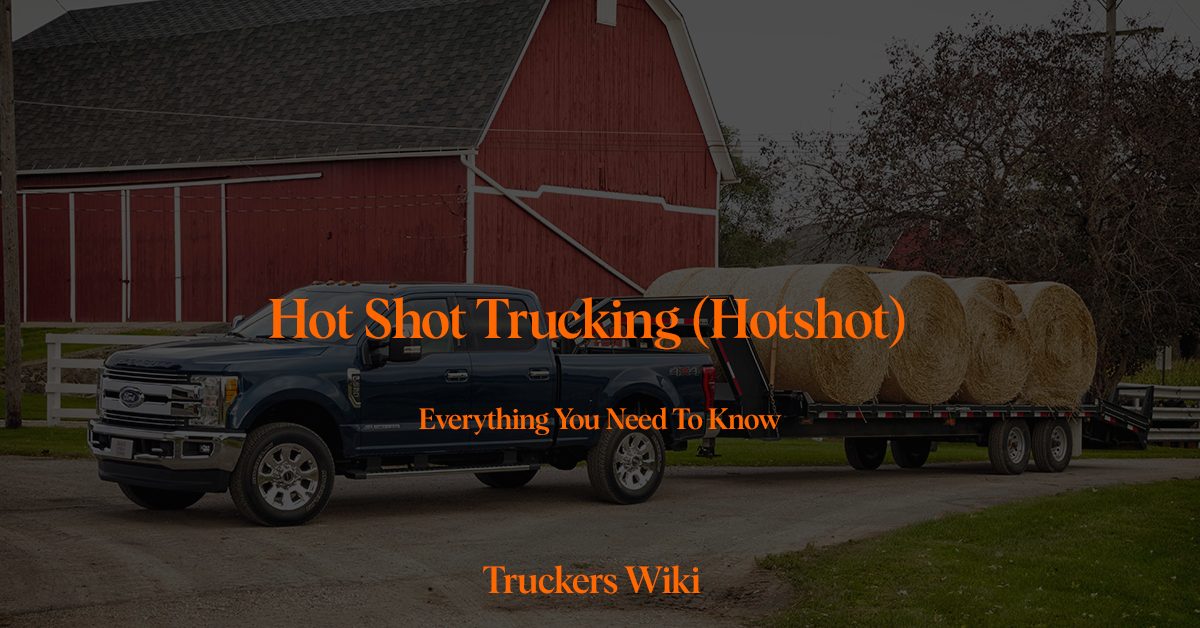
Table of Contents
What is Hot Shot Trucking?
Hot shot trucking or hotshot refers to the transport of freight that is time-sensitive, lighter and smaller and usually required to be delivered as soon as possible. The term originated in the oil industry in Texas, where parts were needed urgently to ensure the oil wells continued to operate effectively. In those situations, companies didn’t have the luxury of time to wait for regular freight delivery schedules, so “hot shot” services filled the gap.
Hot shot services use pickup trucks such as Ford F-250 or RAM 3500 (one-ton trucks) or medium-duty trucks, often coupled with gooseneck trailers, to transport goods. Because the vehicles used in hot shot trucking are smaller and more maneuverable than traditional semi-trucks, they can deliver goods more quickly and to locations that larger trucks might struggle to access.
Hot Shot Regulations
The maximum freight weight allowed for hot shot trucking can vary based on a few factors such as the specific vehicle, trailer setup, and regulations of the region where the driver is operating.
However, a key threshold in the United States is set by the Federal Motor Carrier Safety Administration (FMCSA). If a hot shot truck and trailer combination has a Gross Vehicle Weight Rating (GVWR) over 26,000 pounds, and if the trailer’s GVWR is more than 10,000 pounds, the driver will need a Commercial Driver’s License (CDL) and must comply with additional regulations, including hours of service rules and regular Department of Transportation (DOT) inspections.
Typically, hot shot truckers aim to keep their loads below these thresholds to avoid needing a CDL and to maintain greater flexibility in their operations. That said, many hot shot operators do hold CDLs and run larger setups in order to take advantage of more lucrative freight opportunities.
It’s also important to note that individual states can have their own requirements, so drivers should always check local regulations. Furthermore, the weight of the freight must be distributed properly to maintain safe handling characteristics of the vehicle.
For example, a one-ton pickup truck paired with a dual-axle gooseneck trailer might be able to handle freight up to around 15,000 pounds, keeping the total weight under the 26,000-pound threshold, but this can vary based on the specific equipment.
Always remember, regardless of the weight your rig can theoretically handle, safety should be the top priority. Overloading a vehicle can lead to poor handling, increased stopping distances, and a higher risk of accidents or mechanical failures.
Hotshot Freight
You can already guess that the most common hotshot freight is: oil and gas equipment, construction materials and equipment, automotive parts, agricultural supplies, tradeshow and event materials to name a few.
Pulling a 40 Ft trailer means it can ship any cargo weighing more than 16500 pounds. This makes hotshot trucking perfect for shipping tractors and other farm equipment.
Key Characteristics of Hot Shot Trucking
1. Urgency:
The primary trait of hot shot trucking is urgency. Hot shot deliveries are typically time-sensitive and may need to be delivered within a few hours or by the next day.
2. Size and Weight of Loads:
Hot shot loads are generally smaller and lighter than standard truckloads. The typical weight for a hot shot load is under 10,000 pounds.
3. Versatility:
Hot shot trucks are smaller, more versatile, and able to access locations that larger trucks cannot. They can often deliver directly to the job site or end-user, bypassing distribution centers.
4. Equipment:
The most common setup for hot shot trucking is a medium-duty or one-ton truck, such as a flatbed or dually pickup, combined with a large gooseneck trailer.
Opportunities and Challenges in Hot Shot Trucking
The hot shot trucking industry offers several opportunities. For drivers, it can be an attractive career option as it often provides more flexibility than traditional truck driving jobs. The smaller vehicles are also generally easier to handle, and the ability to deliver directly to customers can make the work more varied and interesting.
For businesses, using hot shot trucking services can help meet urgent delivery needs and reduce downtime, particularly in industries like construction or oil and gas where delays can be extremely costly.
However, hot shot trucking also presents some challenges. The urgent nature of the work can mean unpredictable schedules and last-minute jobs. The loads are also generally less profitable than full truckloads, so hot shot drivers may need to make more deliveries to achieve the same income.
Moreover, hot shot trucking businesses need to ensure they comply with all relevant regulations, particularly those relating to weight limits and driver hours. For instance, if a hot shot truck and trailer combination exceeds a certain weight, it falls under Federal Motor Carrier Safety Administration (FMCSA) regulations, and the driver will need a CDL.
Conclusion
Hot shot trucking is a unique segment of the trucking industry that caters to urgent, smaller freight loads. It provides significant opportunities for both drivers and businesses but is not without its challenges. Understanding the nature of hot shot trucking, the equipment needed, and the associated regulations is crucial for anyone interested in this fast-paced, dynamic part of the commercial transport sector. Whether for a career change or as a business service, hot shot trucking represents an exciting component of the logistics landscape.

